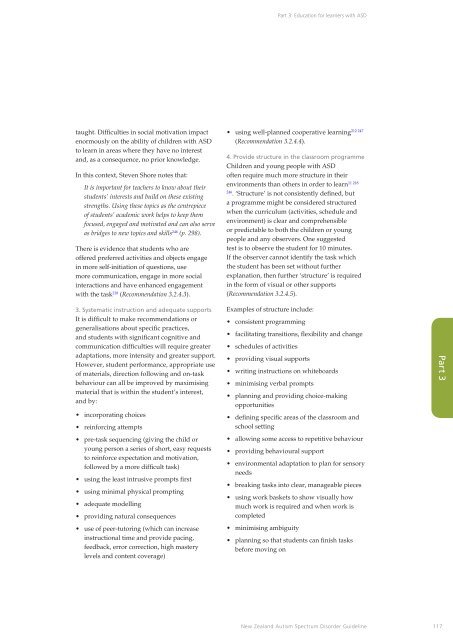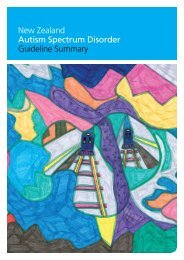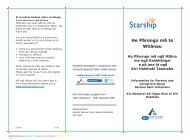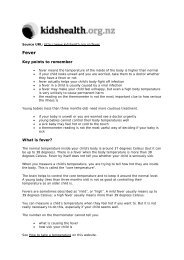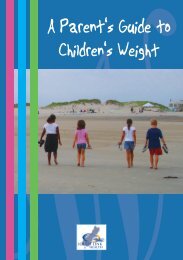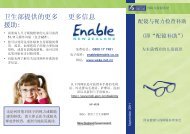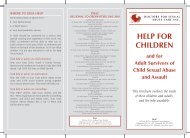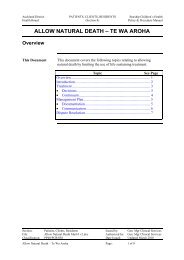New Zealand Autism Spectrum Disorder Guideline - Ministry of Health
New Zealand Autism Spectrum Disorder Guideline - Ministry of Health
New Zealand Autism Spectrum Disorder Guideline - Ministry of Health
Create successful ePaper yourself
Turn your PDF publications into a flip-book with our unique Google optimized e-Paper software.
Part 3: Education for learners with ASD<br />
taught. Difficulties in social motivation impact<br />
enormously on the ability <strong>of</strong> children with ASD<br />
to learn in areas where they have no interest<br />
and, as a consequence, no prior knowledge.<br />
In this context, Steven Shore notes that:<br />
It is important for teachers to know about their<br />
students’ interests and build on these existing<br />
strengths. Using these topics as the centrepiece<br />
<strong>of</strong> students’ academic work helps to keep them<br />
focused, engaged and motivated and can also serve<br />
as bridges to new topics and skills 246 (p. 298).<br />
There is evidence that students who are<br />
<strong>of</strong>fered preferred activities and objects engage<br />
in more self-initiation <strong>of</strong> questions, use<br />
more communication, engage in more social<br />
interactions and have enhanced engagement<br />
with the task 218 (Recommendation 3.2.4.3).<br />
212 247<br />
• using well-planned cooperative learning<br />
(Recommendation 3.2.4.4).<br />
4. Provide structure in the classroom programme<br />
Children and young people with ASD<br />
<strong>of</strong>ten require much more structure in their<br />
11 218<br />
environments than others in order to learn<br />
246<br />
. ‘Structure’ is not consistently defined, but<br />
a programme might be considered structured<br />
when the curriculum (activities, schedule and<br />
environment) is clear and comprehensible<br />
or predictable to both the children or young<br />
people and any observers. One suggested<br />
test is to observe the student for 10 minutes.<br />
If the observer cannot identify the task which<br />
the student has been set without further<br />
explanation, then further ‘structure’ is required<br />
in the form <strong>of</strong> visual or other supports<br />
(Recommendation 3.2.4.5).<br />
3. Systematic instruction and adequate supports<br />
It is difficult to make recommendations or<br />
generalisations about specific practices,<br />
and students with significant cognitive and<br />
communication difficulties will require greater<br />
adaptations, more intensity and greater support.<br />
However, student performance, appropriate use<br />
<strong>of</strong> materials, direction following and on-task<br />
behaviour can all be improved by maximising<br />
material that is within the student’s interest,<br />
and by:<br />
• incorporating choices<br />
• reinforcing attempts<br />
Examples <strong>of</strong> structure include:<br />
• consistent programming<br />
• facilitating transitions, flexibility and change<br />
• schedules <strong>of</strong> activities<br />
• providing visual supports<br />
• writing instructions on whiteboards<br />
• minimising verbal prompts<br />
• planning and providing choice-making<br />
opportunities<br />
• defining specific areas <strong>of</strong> the classroom and<br />
school setting<br />
Part 3<br />
• pre-task sequencing (giving the child or<br />
young person a series <strong>of</strong> short, easy requests<br />
to reinforce expectation and motivation,<br />
followed by a more difficult task)<br />
• using the least intrusive prompts first<br />
• using minimal physical prompting<br />
• adequate modelling<br />
• providing natural consequences<br />
• use <strong>of</strong> peer-tutoring (which can increase<br />
instructional time and provide pacing,<br />
feedback, error correction, high mastery<br />
levels and content coverage)<br />
• allowing some access to repetitive behaviour<br />
• providing behavioural support<br />
• environmental adaptation to plan for sensory<br />
needs<br />
• breaking tasks into clear, manageable pieces<br />
• using work baskets to show visually how<br />
much work is required and when work is<br />
completed<br />
• minimising ambiguity<br />
• planning so that students can finish tasks<br />
before moving on<br />
<strong>New</strong> <strong>Zealand</strong> <strong>Autism</strong> <strong>Spectrum</strong> <strong>Disorder</strong> <strong>Guideline</strong> 117


